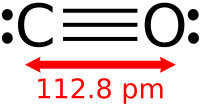
Photo from wikipedia
Abstract High sensitivity of ozone-treated graphene towards detecting NO2 is experimentally reported in literature with a sensor response reaching 1.3 ppb at room temperature. The present investigation focuses on understanding the… Click to show full abstract
Abstract High sensitivity of ozone-treated graphene towards detecting NO2 is experimentally reported in literature with a sensor response reaching 1.3 ppb at room temperature. The present investigation focuses on understanding the mechanisms and reasons behind such a high sensitivity. In this study, the adsorption properties of NO and NO2 molecules on graphene with mono-vacancy (VC) and ozone-treated graphene (OTG) are studied based on density functional theory (DFT). Our theoretical results show that C vacancies have the ability to produce chemisorption with NO, NO2 and O3 molecules. These molecules are shown to be oxidizing to the vacancy and draining charges from the surface. Fermi level of VC and OTG with and without adsorption of gas molecules lies in the middle of conduction band and reveals their metallic character. Based on metallic behavior of studied systems, Drude model of conductivity is explored to evaluate the sensor response towards NO, NO2 and O3. The results show that the chemisorption of NO2 on VC would lead to high sensor response, compared to that of NO and O3. These results are consistent with the experimental data.
Journal Title: Surface Science
Year Published: 2019
Link to full text (if available)
Share on Social Media: Sign Up to like & get
recommendations!